Sir Patrick Geddes και Lewis Mumford: Οι ιδέες τους είναι ακόμη στο προσκήνιο
DS.WRITER:
Christina Ioakeimidou
Κεντρική Εικόνα: scottishinsight.ac.uk
Από το Survey Plan, στο Garden City Movement και τις σκέψεις περί αστικής βιωσιμότητας. Μία σύντομη αναφορά στις ιδέες που επιχείρησαν να αλλάξουν τον τρόπο σχεδιασμού και ανάπτυξης του αστικού ιστού.
Ο Sir Patrick Geddes δεν μπορεί να προσδιοριστεί απλώς ως βιολόγος, κοινωνιολόγος ή τοπογράφος. Ήταν ο άνθρωπος που μπόρεσε να ενσωματώσει θεωρητικά και πρακτικά όλους τους προαναφερθέντες κλάδους σε ένα ενιαίο φάσμα μελέτης της ζωής. Εισήγαγε πρώτος τον όρο του region στην τοπογραφική πράξη, έναν όρο που δανείστηκε από τη φιλοσοφική σκέψη των Auguste Comte και Frederic LePlay, ενώ μέσω της ανάπτυξης του neotechnics στόχευε στον επαναπροσδιορισμό του κόσμου και την απομάκρυνσή του από τη λογική του υπερτονισμού του χρήματος και της άκρατης εμπορευματοποίησης. Η θεωρητική του σκέψη και η πίστη του στον συγκερασμό του αστικού σχεδιασμού με τη φύση, είναι περισσότερο επείγουσες από ποτέ.
O S. Patrick Geddes και το Religion of Humanity
Γεννημένος στο Ballater της Σκωτίας το 1854, ο Geddes φοίτησε στο Royal College of Mines του Λονδίνου, δίπλα στον βοτανολόγο Thomas Henry Huxley. Κατά τη διάρκεια της παραμονής του στην πόλη, ήρθε κοντά στον Θετικισμό -σκέψη του Auguste Comte,- γεγονός που φαίνεται να επηρέασε βαθύτατα τη δική του ιδεολογική και επαγγελματική πορεία. Δεν είναι τυχαίο το γεγονός ότι στράφηκε στη Religion of Humanity, μία κοσμική θρησκεία που είχε ως βάση τον δημόσιο σεβασμό της Ανθρωπότητας. Ίσως, μέσω του σεβασμού της Ανθρωπότητας και της νόησής της ως όλου, ο Geddes να βρήκε τον τρόπο ανάπτυξης μιας σκέψης που θα συμπεριελάμβανε την ανασύσταση των νέων αστικών κέντρων με γνώμονα τη βιωσιμότητα, έναν όρο που εισήχθη στη δημόσια συζήτηση πολύ αργότερα.
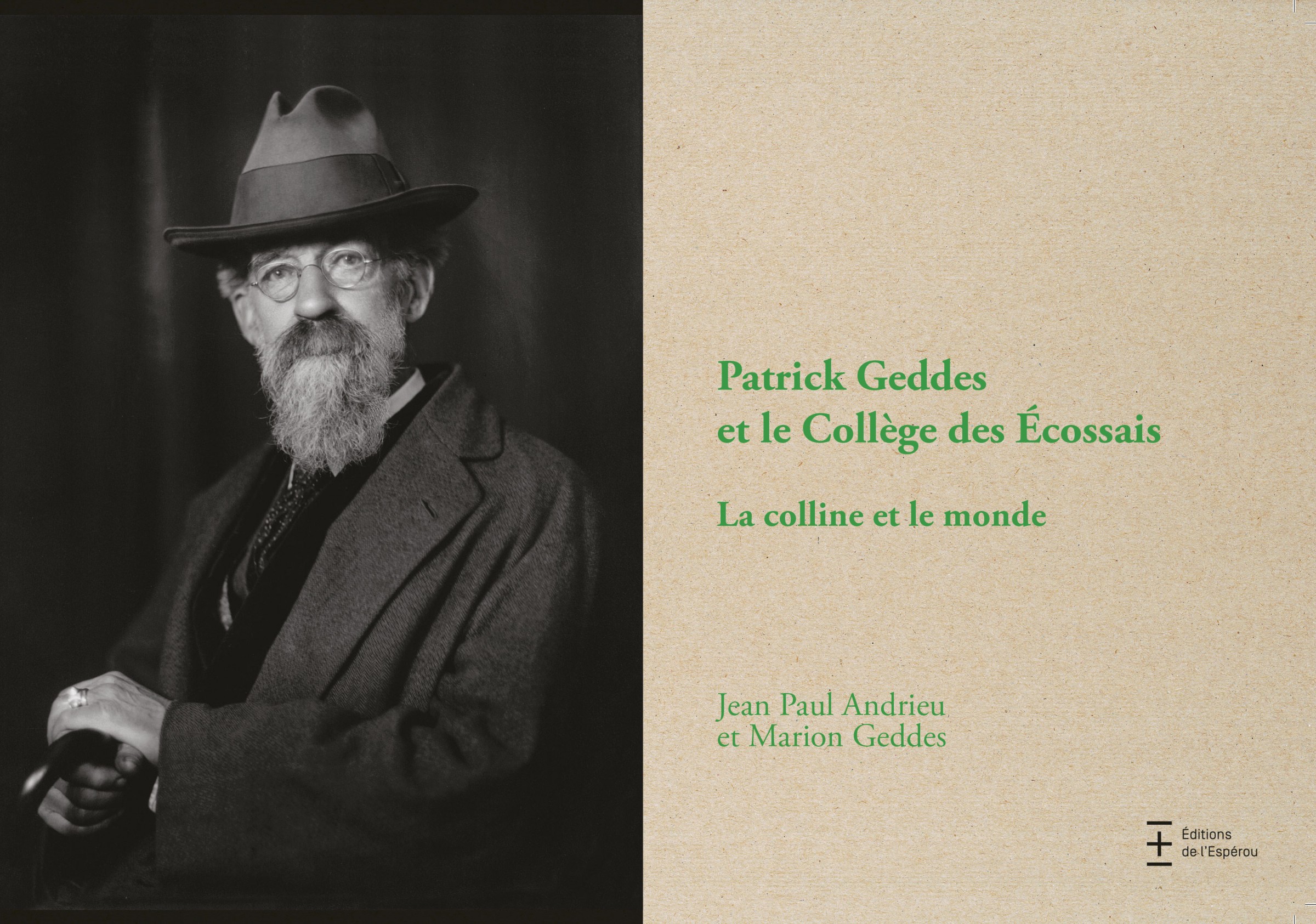
Ο Sir Patrick Geddes ήταν ιδρυτής της Collège des Écossais, στο Μονπελιέ (έτος ίδρυσης 1954) | Πηγή εικόνας: esperou.montpellier.archi.fr
Πώς όμως ένας βιολόγος έθεσε τα θεμέλια για το γνωστό δόγμα «survey before plan»; Για την απάντηση της ερώτησης, θα πρέπει πρώτα να εξηγήσουμε το πώς ο ίδιος στράφηκε στη μελέτη του αστικού τοπίου. Όντας ο ίδιος βιολόγος, στρεφόμενος στην κοινωνιολογική σημασία του αστικού περιβάλλοντος, προσπάθησε να συμπεριλάβει στη θεωρητική του προσέγγιση μία βιοπεριφερειακή οπτική, που θα ανταποκρινόταν στη λογική της διάγνωσης του προβλήματος πριν τη θεραπεία. Αυτή περιλαμβάνει οικονομικοκοινωνικές και πολιτισμικές εκτιμήσεις της οικολογικής κατανόησης της βιόσφαιρας, η οποία για να επιτευχθεί θα πρέπει να αναπτυχθεί μία περισσότερο διεπιστημονική έρευνα και συνεργασία πολλαπλών κλάδων. Έτσι, ο σχεδιασμός και η μελέτη -που πάντα θα πρέπει να προηγείται- θα γίνονται με βάση την ένωση των εκάστοτε επιστημονικών κλάδων, ούτως ώστε να ολοκληρωθεί, ομαλότερα, η μετάβαση σε ένα πιο βιώσιμο οικιστικό σύνολο.
Όμως, αυτό θα ολοκληρωθεί μόνο όταν νοηθεί ο κόσμος ως όλον, ως μία δυναμική «συνεργασία» των διαφόρων τομέων της ζωής, συμπεριλαμβανομένων αυτών της φύσης. Συνεπώς, όπως υπάρχει η κοινωνιολογία ή η μηχανική, θα πρέπει να συμπεριλαμβάνεται και η οικολογική σκέψη στη διαμόρφωση ενός βιώσιμου αστικού τοπίου. Χωρίς την τελευταία δεν θα μπορέσει να υπάρξει η προσαρμογή του ατόμου σε μια συγκεκριμένη περιοχή κατοίκησης και οικονομικής δράσης, οδηγώντας έτσι στην απουσία τής οποιασδήποτε ανάπτυξης.
Πώς θα αποκρυσταλλωθεί αυτή η θεωρητική προσέγγιση του Geddes για τη μελέτη και την κατανόηση της τοπικής και μετέπειτα της παγκόσμιας αντίληψης του κόσμου; Ίσως το Outlook Tower να εμπεριέχει, κάπως απλοποιημένα, τη φιλοσοφία του Patrick Geddes.
Outlook Tower και η αρχή μιας ολόκληρης σχολής σκέψης
Το 1892, ο Geddes αγόρασε έναν πύργο που βρισκόταν δίπλα από το Κάστρο του Εδιμβούργου. Ο πύργος, γνωστός και ως Outlook Tower (σήμερα στον πύργο λειτουργεί το μουσείο-έκθεση Camera Obscura & World of Illusions), θα μετατρεπόταν, σε λιγότερο από 20 χρόνια, σε ένα «μηχάνημα» που σκοπό είχε την απεικόνιση της σχέσης του ιδιωτικού με τον εξωτερικό κόσμο.
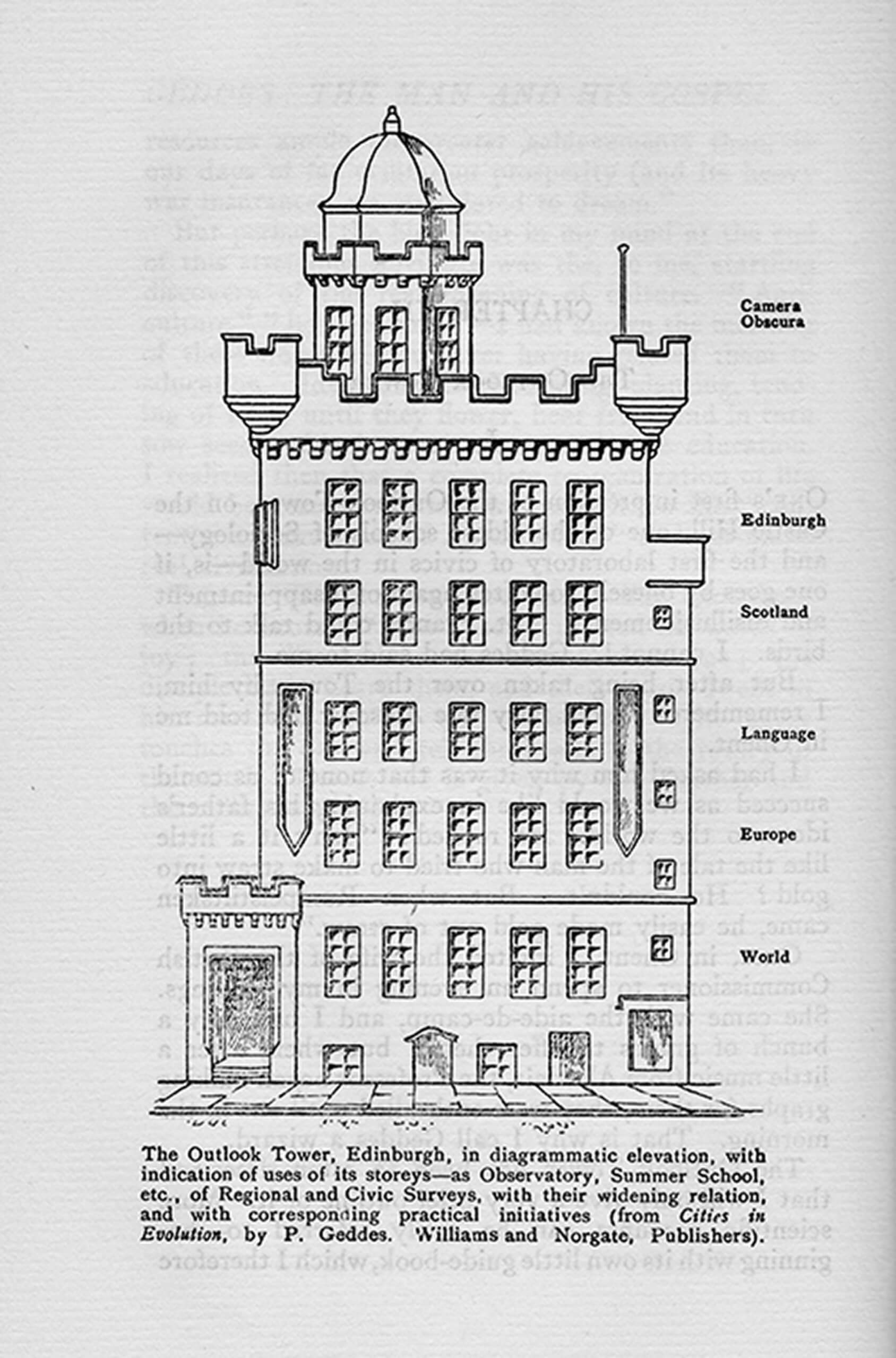
Διάγραμμα του πύργου Outlook | Πηγή εικόνας: euppublishingblog.com
Ο πύργος αποτελείται από μια κατακόρυφη ακολουθία χώρων, ο καθένας από τους οποίους προσδίδει στον επισκέπτη μία διαφορετική εμπειρία. Από τα δωμάτια ξεχωρίζουν αυτά του Διαλογισμού, ένα σκοτεινό κελί, η βεράντα, καθώς και η Camera Obscura που προϋπήρχε στο κτίσμα. Μάλιστα, το συγκεκριμένο δωμάτιο ήταν -και είναι- το πιο εντυπωσιακό, αφού, με τη χρήση ενός καθρέπτη, οι ακτίνες φωτός αντανακλώνται διαμέσου ενός συστήματος φακών, σε έναν σκοτεινότερο χώρο. Σε αυτόν τον χώρο, η προβολή του εξωτερικού τοπίου γίνεται ορατή πάνω σε ένα κυκλικό λευκό τραπέζι.

Τρόπος λειτουργίας της Camera Obscura | Πηγή εικόνας: iiif.wellcomecollection.org
Το εν λόγω εγχείρημα του Patrick Geddes βασίζεται σε μια διαφορετική ιδέα αντίληψης του σύμπαντος. Συνεπώς, κατά τον ίδιο, για να καταλάβει κάποιος τον κόσμο ως όλον, πρέπει αρχικά να έχει αντιληφθεί τη σημασία του τοπικού. Ωστόσο, αυτή η κατανόηση του πλησίον μας χώρου δεν γίνεται ραγδαία, αλλά σταδιακά. Αφού κανείς βλέπει αρχικά την πόλη του Εδιμβούργου, μετέπειτα περνά νοητά στη Σκωτία, στις αγγλόφωνες χώρες, στην Ευρώπη και στο τέλος στον κόσμο.
Αυτή η ιδεολογική κατεύθυνση, που ξεκίνησε από τον πύργο Outlook, θα συνεχιστεί από τον Geddes μέχρι την ανάπτυξη του Valley Section. Το τελευταίο θα αποτελέσει και τομή στη σκέψη, για μια περισσότερο οικολογική προσέγγιση της διαμόρφωσης των πόλεων.
Σκέψεις περί αστικής βιωσιμότητας
Στις 18 Ιουλίου 1904, ο Patrick Geddes θα δώσει μια άκρως ενδιαφέρουσα ομιλία στο London University. Στο κοινό, μάλιστα, ήταν και ο Ebenezer Howard, εισηγητής του Garden City Movement.
Ο Geddes, κατά τη διάρκεια της ομιλίας του, διηγείται παραστατικά και δημιουργεί την εξής εικόνα: Στην αρχή υπάρχουν απέραντες καλλιεργήσιμες πλαγιές με μικρά χωριά, που στη συνέχεια οδηγούν σε ορεινούς οικισμούς. Από εκεί ο νους του θεατή-ακροατή κατηφορίζει στα πιο ακμαία χωριά στους πρόποδες του βουνού και στον σιδηροδρομικό σταθμό. Φυσικά, από την εικόνα δεν θα έλειπε η μεγάλη, κεντρική πόλη, που βρίσκεται ανάμεσα στον ποταμό και τη γεωργική περιοχή. Ωστόσο, η εικόνα-διήγηση δεν σταματά εκεί, αφού πιο μακριά υπάρχει η μεγαλύτερη πόλη της συγκεκριμένης, φανταστικής κομητείας, ενώ λίγο πιο κάτω βρίσκεται η βιομηχανική πόλη, οι καπνοί της οποίας φαίνονται από πολύ μακριά. Αυτή είναι και η «παγκόσμια πόλη».
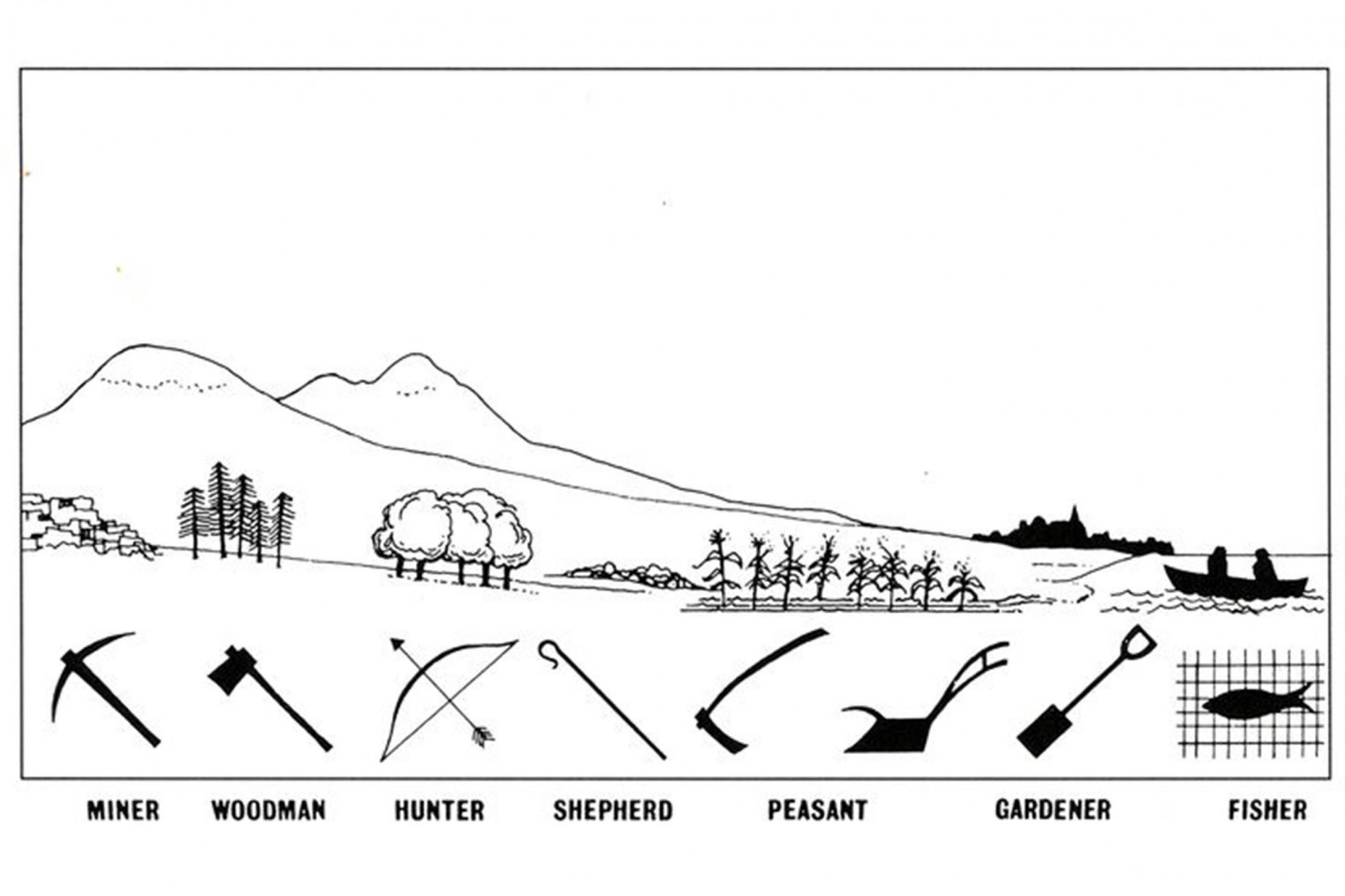
Σχεδιάγραμμα του Valley Section | Πηγή εικόνας: ciclica.eu
Αυτή η περιγραφή είναι και η βάση της ιδεολογίας του ίδιου. Μιας σκέψης που αποκρυσταλλώνει την ιδανική αστική συνθήκη και φανερώνει την εξέλιξη του πολιτισμού, από τις απλούστερες στις πιο σύνθετες μορφές κατοίκησης. Θα λέγαμε, ότι η θεωρία του Διαφωτισμού περί Κοινωνικής εξέλιξης απεικονίζεται στο σχεδιάγραμμα του Geddes, αφού έχουμε τα τέσσερα στάδια του κυνηγιού, του αγροτικού και του γεωργικού τομέα, οι οποίοι εν τέλει καταλήγουν στην εμπορική ανάπτυξη. Συνεπώς, τα ξεχωριστά τμήματα (regions) της κοιλάδας -ή, κατ’ άλλους, οι διαφορετικές κοιλάδες- συνυπάρχουν, και μαζί με αυτά συμβιώνουν αρμονικά και οι κάτοικοι ή οι επαγγελματίες που δραστηριοποιούνται σε αυτά.
Τι είναι, όμως, αυτό που συνδέει το Valley Section με το «survey before plan»; Ίσως, όπως προαναφέρθηκε, η απάντηση είναι ξεκάθαρη, αν σκεφτούμε το αστικό περιβάλλον σαν έναν ζωντανό οργανισμό, όπου τα μέρη, αν και διαφοροποιημένα, συνεργάζονται άρτια για τη σωστή λειτουργία του όλου. Ωστόσο, πάντα θα πρέπει να λαμβάνονται υπόψη έστω και οι ελάχιστες τροποποιήσεις, ούτως ώστε να μελετώνται και να δίνονται νέες λύσεις, βασισμένες και σεβόμενες πάντα το παρελθόν. Ο πολιτισμός, η οικονομία, η κοινωνία και οι οικολογικές ανησυχίες είναι απαραίτητο να συμβαδίζουν και να οδηγούν σε ένα καλύτερο, πιο φιλικό και βιώσιμο μέλλον, απόψεις που θα αναπτυχθούν αισθητά στα μέσα του 20ού αιώνα. Ως εκ τούτου, ο Geddes φαίνεται να ήταν ο πρώτος που μίλησε για την αναγκαιότητα μελέτης του τρόπου που ο περιφερειακός και πολεοδομικός σχεδιασμός θα μπορέσει να ενσωματώσει τον άνθρωπο και τις βιοποριστικές του ασχολίες στο περιβάλλον, μέσω της λεπτομερούς έρευνας των διαφόρων παραμέτρων -περιβαλλοντικών και κοινωνικοοικονομικών- της ενδιαφερόμενης περιοχής.
Ο βιοπεριφερειακός σχεδιασμός που εισήγαγε ο Geddes και η ομιλία του 1904, ήταν αναμενόμενο να επηρεάσουν και τα μεγάλα κινήματα, όπως το Garden City Movement. Το κίνημα που πρωτοεισήγαγε ο Ebenezer Howard μέσω του Tomorrow: A Peaceful Path to Social Reform (1898), είχε στόχο τη βελτίωση της ποιότητας ζωής στην πόλη και την αντιμετώπιση των προβλημάτων που έφερε η ραγδαία βιομηχανική ανάπτυξη. Το πρόγραμμα του κινήματος βασιζόταν στον σχεδιασμό μικρών πόλεων -πάντα περιορισμένης έκτασης-, που θα αποτελούνταν στην εξωτερική περιφέρειά τους από αγροτικές εκτάσεις, ενώ εκτός θα υπήρχαν οι κατοικίες. Φυσικά, ο Howard δεν ήταν αφοριστικός αναφορικά με τη βιομηχανία (το ίδιο ισχύει και για τον Geddes, όπως είδαμε στην περιγραφή του Valley Section), αφού το εσωτερικό αυτών των κηπουπόλεων θα συμπεριελάμβανε και τις κάθε είδους επαγγελματικές ασχολίες των κατοίκων. Χαρακτηριστικό παράδειγμα μιας τέτοιας πόλης είναι αυτό του Letchworth, κοντά στο Λονδίνο, και του Welwyn, μίας παρακείμενης του Letchworth πόλης.
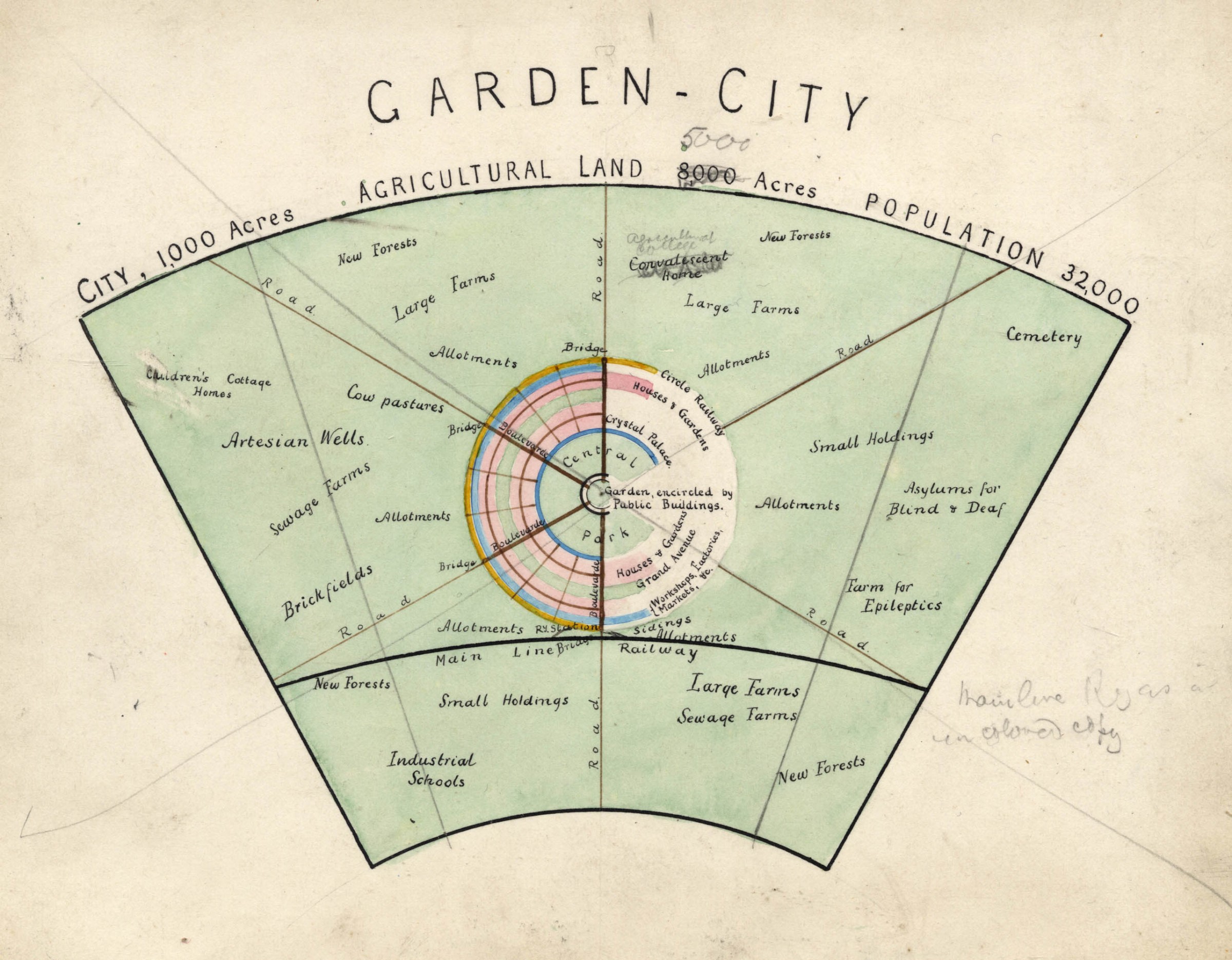
Σχέδιο του Howard για το Letchworth | Πηγή εικόνας: hertsmemories.org.uk
Βάσει των παραπάνω βλέπουμε ότι, ίσως οι ιδέες του Geddes περί ολιστικής έρευνας για τον αστικό σχεδιασμό, να βρήκαν την εφαρμογή τους στα σχέδια του Garden City Movement.
Μια ομογενής πόλη για ένα καλύτερο μέλλον
Η αρμονική συνύπαρξη μέσα στην πόλη προϋποθέτει την ανυπαρξία διαχωρισμού και την ανάπτυξη μιας φιλοσοφίας επικοινωνίας των πολιτών. Η συμμετοχή των πολιτών, η διατήρηση και συντήρηση των αστικών χώρων και η προσπάθεια των πολιτών για τη δημιουργία μιας αυτόνομης πόλης, προσανατολισμένης σε έναν περισσότερο οικολογικό τρόπο ζωής μακριά από την άκρατη εκβιομηχάνιση -πράγματι αυτή η σκέψη μας θυμίζει τον William Morris-, οδήγησαν τον ίδιο σε μελέτες σχεδιασμού πόλεων στην Ινδία και την ανατολική λεκάνη της Μεσογείου, πάντα με γνώμονα την αναβάθμιση περιοχών και την ανάδειξη της σπουδαιότητας της αξιοπρεπούς διαβίωσης.
Όμως, οι προτάσεις του δεν εισακούστηκαν, ενώ ακόμα και χλευάστηκαν από πολλούς σύγχρονούς του. Από την αφάνεια βγήκε, όταν ο τότε φοιτητής Lewis Mumford -για τον οποίο θα υπάρξει εκτεταμένη αναφορά στο επόμενο, δεύτερο μέρος του αφιερώματος στις ιδέες περί βιωσιμότητας- επικοινώνησε μαζί του, με σκοπό να γίνει ο μαθητής του. Μέσω του Mumford και των κειμένων του στο New Yorker, η σκέψη του Patrick Geddes αναγεννήθηκε, αποτελώντας πηγή αναφοράς για άλλους κριτικούς αρχιτεκτονικής και τοπογράφους. Ως εκ τούτου, η σκέψη περί συνεχούς εξέλιξης της πόλης, που πάντα θα έπρεπε να είναι σε εγρήγορση με απώτερο σκοπό την ανάπτυξη, βρέθηκε στο επίκεντρο των συζητήσεων των μέσων του 20ού και του 21ου αιώνα, εκφραζόμενη από πολλούς θεωρητικούς, όπως την Jane Jacobs, τον Christopher Alexander κ.α.
Επομένως, θα λέγαμε ότι η σκέψη του Patrick Geddes είναι πάντα επίκαιρη και καίριας σημασίας, ειδικά σήμερα, που η συνεχής τάση προς την παγκοσμιοποίηση και ο νεοφιλελευθερισμός έχουν κάπως απορρυθμίσει την κοινωνική και αστική συνοχή. Ίσως, αν ξανασκεφτούμε την ιδεολογική βάση των λεγομένων του Geddes, να μπορέσουμε να καταλάβουμε ότι όλα μπορούν να συνυπάρξουν, να εξελιχθούν και να στοχεύσουν στη βιωσιμότητα, για την οποία γίνεται τόση συζήτηση.
Δείτε εδώ το Part 2.
Further reading and Sources:
The Living City – The Rise and Fall, and Rise Again of Sir Patrick Geddes. Από: ovalpartnership.com
D. C. Wahl (2017). Visionaries of Regenerative Design I: Sir Patrick Geddes (1854–1931). Από: medium.com
M. Fabrizi (2020). From Vision to Knowledge: Patrick Geddes’ Outlook Tower (1892). Από: socks-studio.com
Garden City. Από: britannica.com
Περισσότερα για τον Sir Patrick Geddes, στο: patrickgeddestrust.co.uk




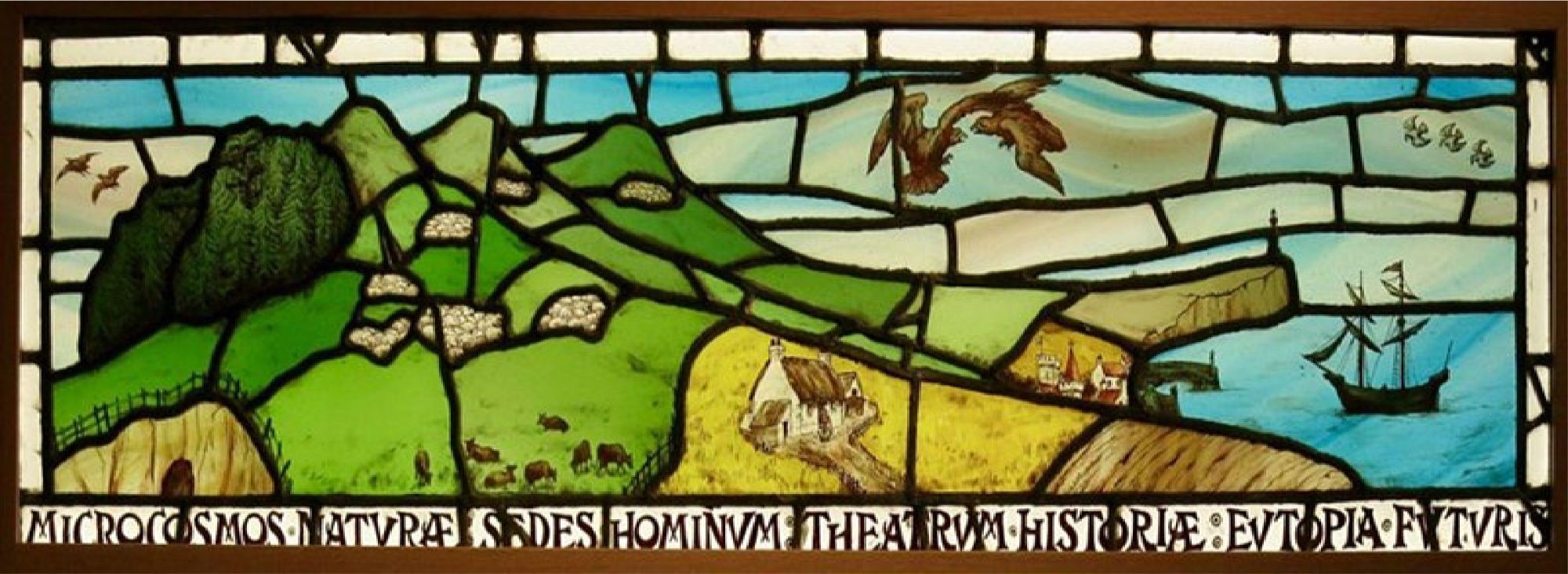
.jpg)
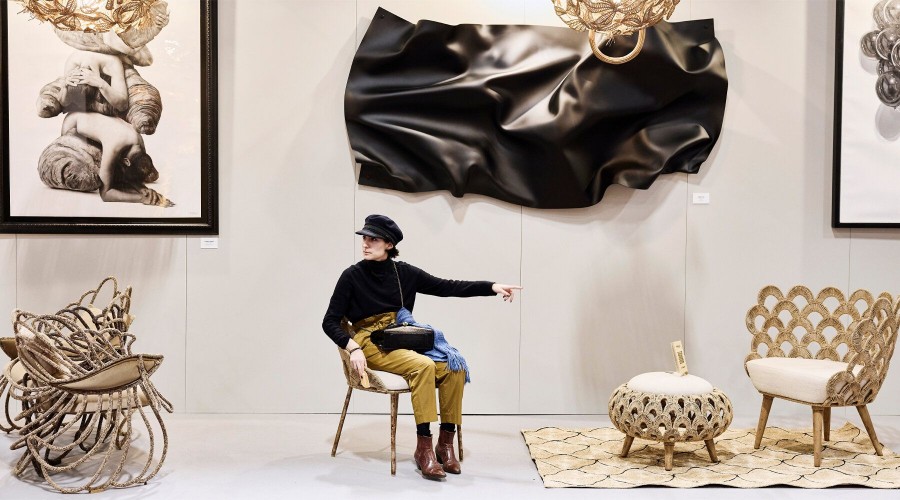
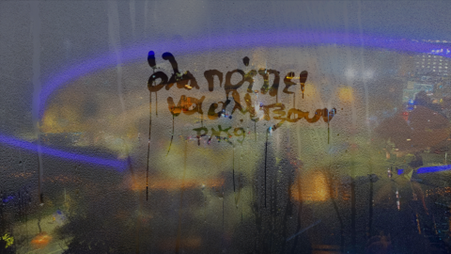
.jpeg)